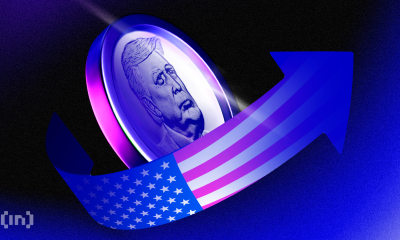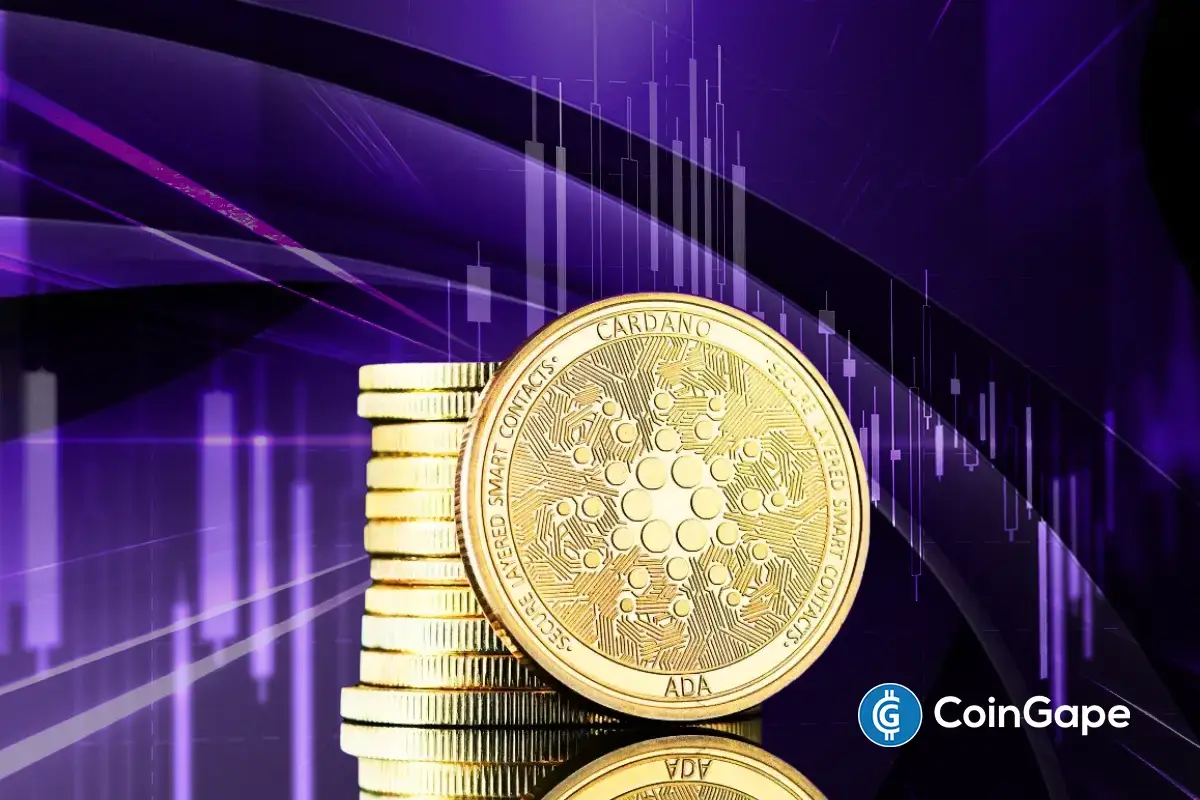Market
Top Crypto News This Week: EigenLayer Upgrade and More

This week is crucial for the crypto market as several significant events are on the horizon. These developments encompass the release of the FOMC minutes, updates on EigenLayer, and the introduction of Arbitrum’s new staking initiative.
Investors and observers pay close attention to these occurrences to assess their potential impact on asset valuation and overall financial movements. Let’s explore what lies ahead in depth.
FOMC Minutes Loom: What’s Next for Bitcoin and the Crypto Market?
The Federal Open Market Committee (FOMC) will release its minutes on August 21 at 14:00 ET. In its previous July meeting, the FOMC decided to keep the Fed Funds interest rate steady at 5.25% to 5.50%. This decision aligned with market expectations and underscored the Federal Reserve’s cautious approach toward inflation.
Fed Chair Jerome Powell hinted at a possible rate cut if inflation continues its downward trend. The market has priced in a potential rate reduction in September, with further cuts anticipated by year-end.
Historical data from 10x Research shows a strong correlation between Bitcoin’s performance and inflation trends. Typically, Bitcoin rallies when inflation decreases, and vice versa. At the time of writing, Bitcoin is trading at $58,575, reflecting a 1.45% decrease in the last 24 hours.
Read more: Bitcoin (BTC) Price Prediction 2024/2025/2030
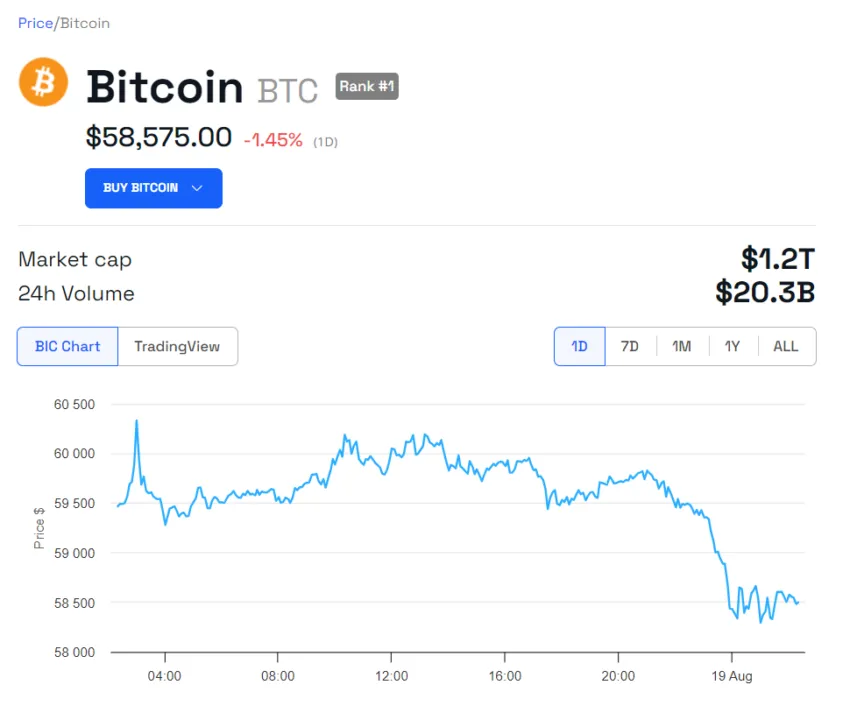
Arbitrum’s New Staking Proposal with stARB Token
On August 16, the Arbitrum Decentralized Autonomous Organization (DAO) approved a proposal to introduce ARB staking for the Ethereum layer-2. The proposal garnered overwhelming support, with 91% of participating voters backing the initiative.
By implementing ARB staking, the governance will actively use only about 10% of the current circulating supply of ARB tokens — roughly 100 million ARB out of the 1 billion in circulation. This new initiative aims to increase voter participation and ensure that the DAO’s decision-making process is more secure and representative of the broader community.
The staking mechanism will introduce a liquid staking token, stARB, which will offer auto-compounding features and compatibility with various DeFi protocols. The initial staking rewards will be streamed from multiple DAO-generated sources, such as sequencer fees, MEV fees, validator fees, token inflation, and treasury diversification. The launch of this staking system is expected to commence in late August, with further updates and specific timelines to be provided in the coming weeks.
EigenLayer Expands ERC-20 Token Support
EigenLayer, a prominent restaking protocol, announced the upcoming release of permissionless token support on its mainnet. This update, expected later this week, will allow users to restake any ERC-20 token, broadening the assets that contribute to the security of decentralized networks.
“Currently, this feature is on the testnet for a short permissioned testing phase. EigenDA will be the first AVS to test and use permissionless token support. Mainnet deployment, a protocol-level update, is scheduled for [this] week. User Interface support for restakers will be added later in Q3,” the EigenLayer team stated.
This expansion marks another milestone for EigenLayer, which continues to dominate the DeFi market. At the time of writing, DefiLlama data shows EigenLayer is the second-largest DeFi protocol, with a total value locked of approximately $12.4 billion.
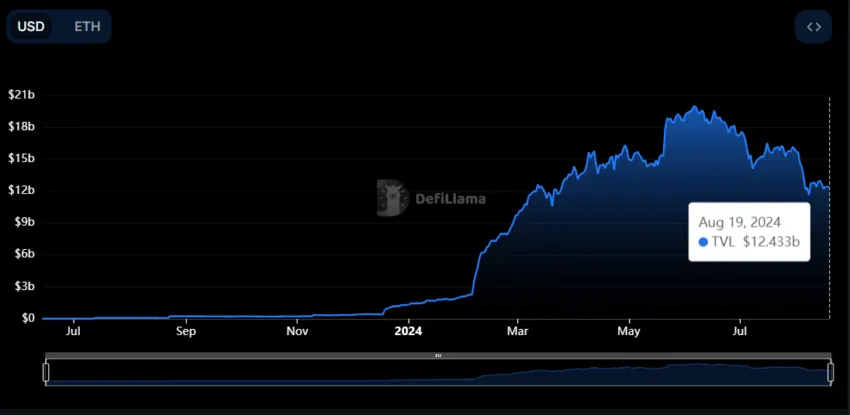
Babylon to Begin Phase 1 of Its Bitcoin Staking Mainnet Launch
This week, Babylon, a Bitcoin staking protocol, will begin phase 1 of its Bitcoin Staking Mainnet Launch. This phase allows Bitcoin holders to start locking their BTC for staking within a secure, self-custodial environment. Stakers can delegate their voting power to a finality provider, with the option to unbond their stake before its expiration.
The initial staking cap is set at 1,000 BTC, with strict limits on transaction sizes to encourage broad participation. While no direct staking rewards will be distributed during this phase, a point system will track stakers’ activities. This system is designed to lay the groundwork for future staking phases.
AVAX and Other Major Token Unlocks This Week
This week will also see significant token unlocks, totaling over $230 million. Among the largest is Avalanche’s release of 9.54 million AVAX tokens, valued at over $197 million. This unlock might influence the asset’s price, especially as no additional tokens will be allocated to the team or strategic partners following this event.
Read more: What Is Avalanche (AVAX)?
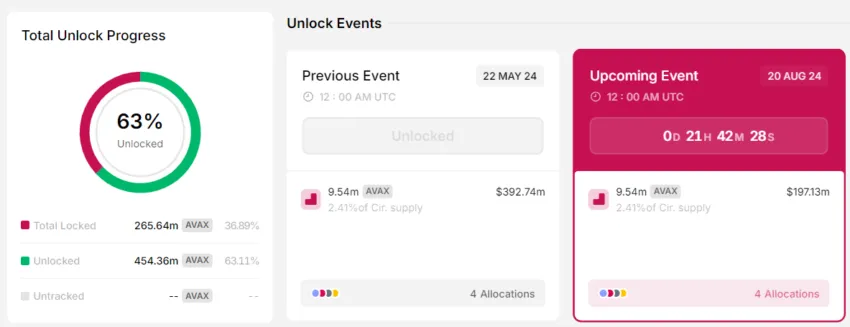
Other major token unlocks include Space ID (ID), PIXEL, and Ethena (ENA). Read this article for further detailed information on major crypto token unlocks this week.
Disclaimer
In adherence to the Trust Project guidelines, BeInCrypto is committed to unbiased, transparent reporting. This news article aims to provide accurate, timely information. However, readers are advised to verify facts independently and consult with a professional before making any decisions based on this content. Please note that our Terms and Conditions, Privacy Policy, and Disclaimers have been updated.
Market
XRP Bears Lead, But Bulls Protect Key Price Zone
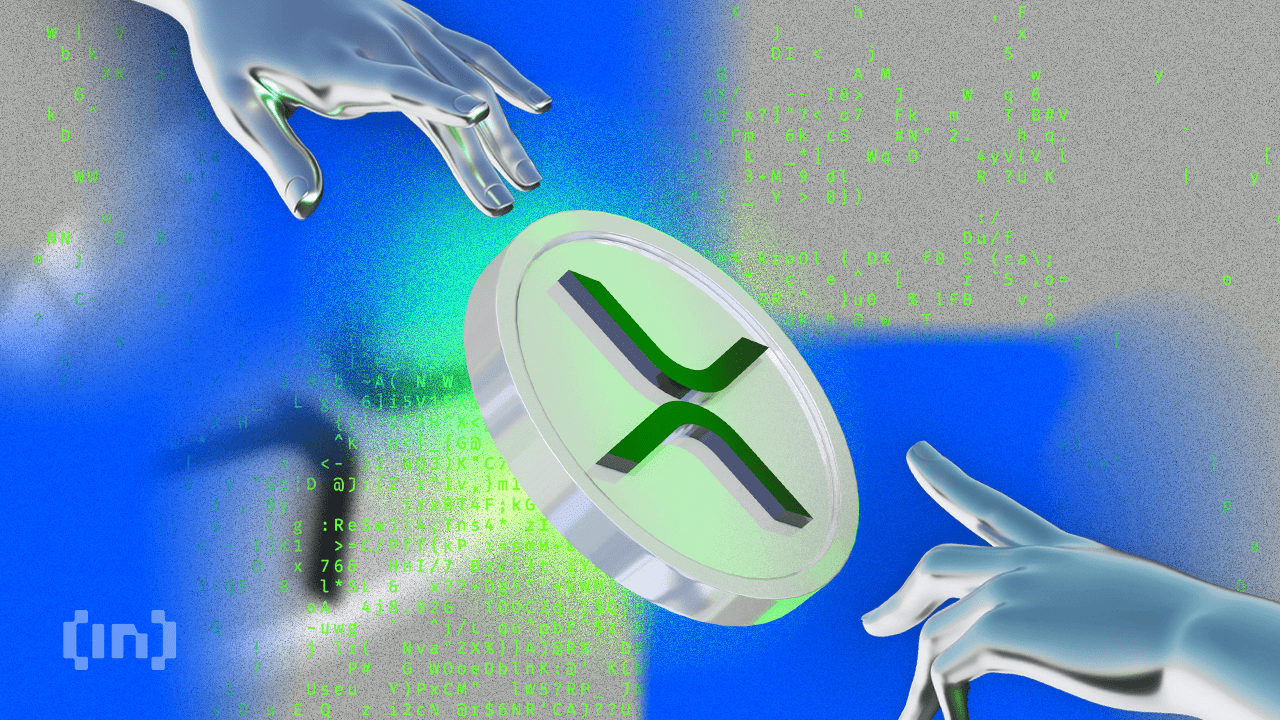
XRP has experienced a significant downturn in recent price action, with its value dropping nearly 15% over the past seven days as bears maintain control of the market. The coin’s technical indicators are showing mixed signals, with the RSI rebounding from oversold territory while Ichimoku Cloud patterns continue to paint a predominantly bearish picture.
Despite yesterday’s test of the critical $2.06 support level resulting in a temporary bounce, the momentum remains negative, with short-term EMAs positioned below long-term averages. The move from extreme oversold conditions suggests XRP might be entering a consolidation phase before its next significant price movement.
XRP RSI Is Up From Oversold Levels
XRP’s Relative Strength Index (RSI) is currently at 36.37, showing a notable rebound from a low of 27.49 just a few hours ago. This upward shift indicates a shift in momentum, as buying interest has started to pick up after a period of heavy selling pressure.
Although still in the lower range, this recovery suggests that traders may be stepping back in. That could mean they are potentially viewing the recent dip as an opportunity.

RSI is a widely used momentum indicator that measures the speed and change of price movements on a scale from 0 to 100. Readings below 30 typically indicate that an asset is oversold and may be undervalued, while readings above 70 suggest it is overbought and could be due for a correction.
XRP’s bounce from 27.49 to 36.37 signals that it may have just exited oversold conditions. This could mean that the recent selling phase is easing. If the buying momentum continues to build, XRP might be entering the early stages of a potential recovery.
XRP Ichimoku Cloud Shows A Bearish Scenario
XRP’s Ichimoku Cloud chart shows that the price action remains below both the red baseline (Kijun-sen) and the blue conversion line (Tenkan-sen). That indicates the prevailing momentum is still bearish.
The candles are also forming well beneath the cloud, which reflects a broader downtrend.
When the price is under all major Ichimoku components like this, it typically signals continued downward pressure unless a strong reversal breaks those resistance levels.
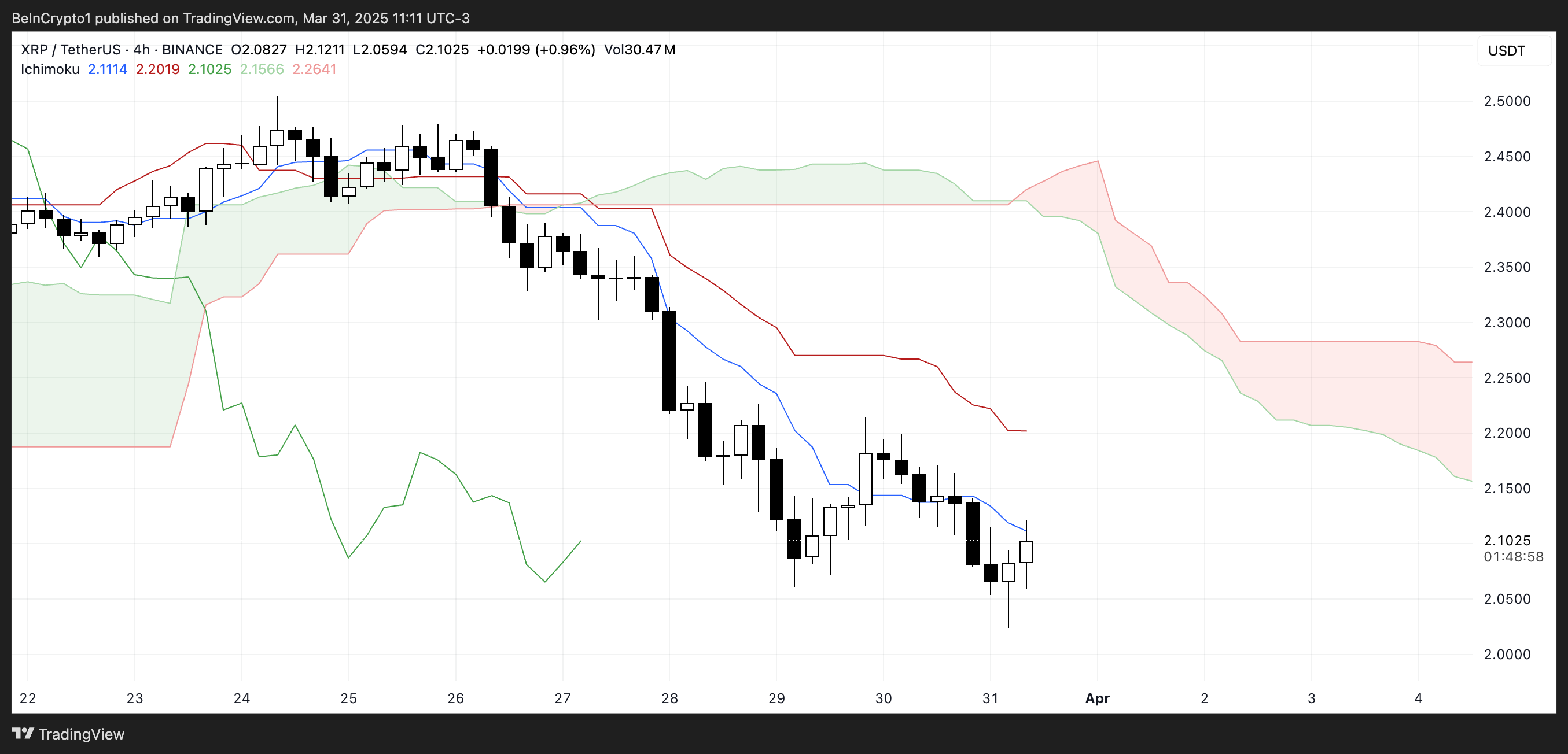
Additionally, the cloud ahead is red and spans horizontally with a downward slope, reinforcing the bearish outlook in the near term. The thickness of the cloud suggests moderate resistance if the price attempts to move upward.
However, some consolidation is evident in the recent candles, showing that sellers may be losing some control.
For any potential trend reversal, XRP would need to break above the Tenkan-sen and Kijun-sen, and eventually challenge the cloud itself — a move that would require a clear uptick in momentum.
XRP Could Rise After Testing An Important Support Yesterday
XRP’s EMA lines are clearly aligned in a bearish formation, with the short-term averages sitting well below the long-term ones and a noticeable gap between them—highlighting strong downward momentum.
Yesterday, XRP price tested the support level at $2.06 and rebounded, showing that buyers are still active at that zone. However, this support remains critical. If it is tested again and fails to hold, XRP could fall further. Its next major support sitting around $1.90.
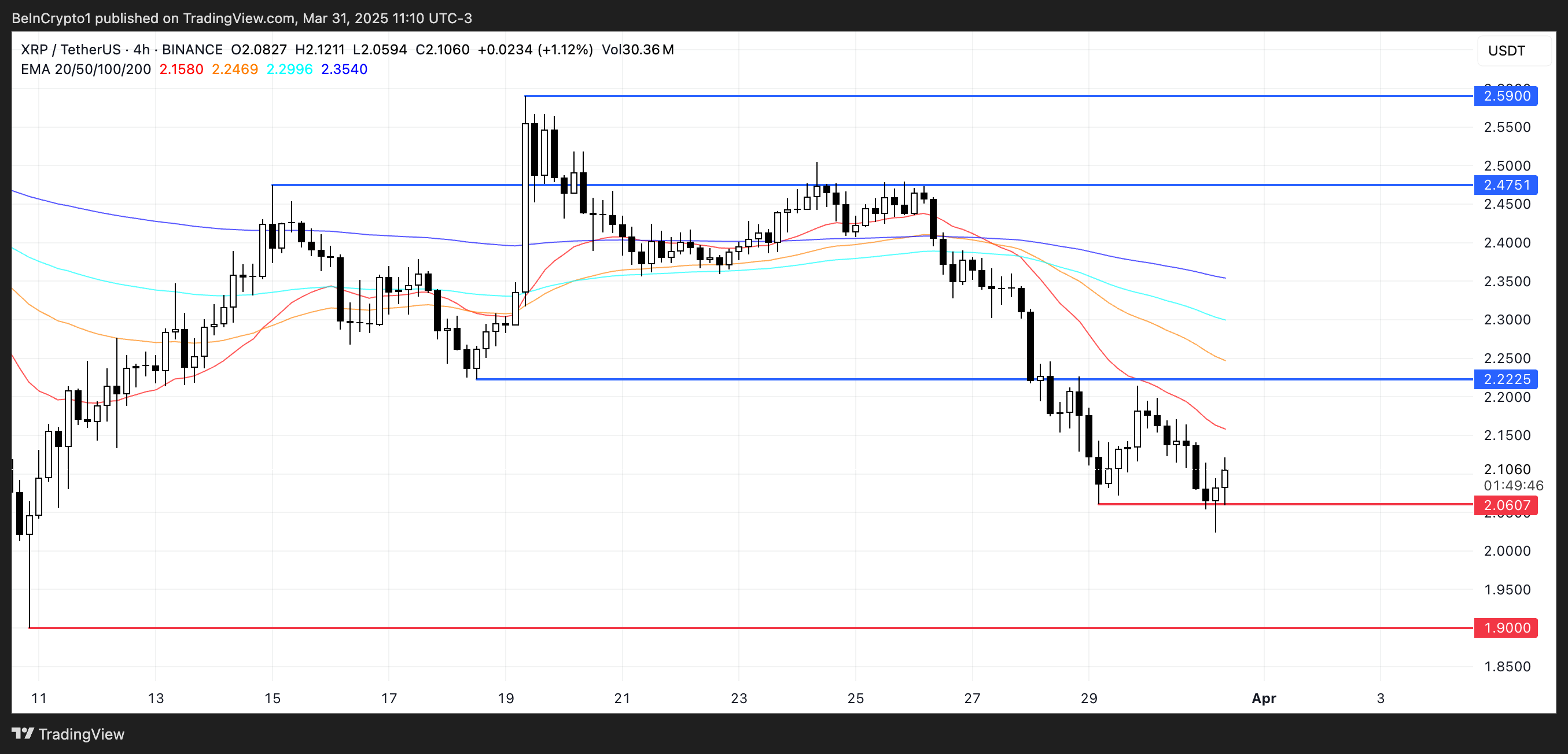
If the trend begins to shift and XRP breaks above the short-term EMAs, the first key resistance to watch is at $2.22. A successful move above this level could trigger a stronger recovery, potentially pushing the price toward $2.47.
If bullish momentum continues, the next upside target would be $2.59. For now, though, the EMA structure still leans bearish. XRP would need sustained buying pressure to flip the trend and aim for those higher resistance levels.
Disclaimer
In line with the Trust Project guidelines, this price analysis article is for informational purposes only and should not be considered financial or investment advice. BeInCrypto is committed to accurate, unbiased reporting, but market conditions are subject to change without notice. Always conduct your own research and consult with a professional before making any financial decisions. Please note that our Terms and Conditions, Privacy Policy, and Disclaimers have been updated.
Market
Market Cap Now Approaching $300 Million

SAFE has emerged as the best-performing altcoin of the day, with its price surging 5% in the last 24 hours and its market capitalization now close to $300 million. The coin is showing strong technical indicators despite some mixed signals from momentum oscillators that suggest consolidation may be on the horizon.
Technical analysis of the EMA lines remains bullish, with short-term averages positioned favorably above long-term ones, pointing to continued strength in the immediate term. However, recent RSI and BBTrend readings indicate a potential cooling-off period could be approaching as the asset digests its recent gains.
SAFE RSI Is Back To Neutral Levels After Reaching Overbought Levels
The SAFE RSI is currently at 54.71, maintaining a neutral position for the past three days after experiencing significant momentum earlier in the week.
This moderation in the indicator suggests that the previous buying pressure has subsided somewhat, allowing the asset to consolidate following recent price movements.
The current neutral reading indicates a balanced market where neither buyers nor sellers have a decisive advantage.

The Relative Strength Index (RSI) is a momentum oscillator that measures the speed and change of price movements on a scale from 0 to 100. Generally, an RSI reading above 70 is considered overbought, suggesting a potential reversal or pullback, while readings below 30 indicate oversold conditions that might precede a bounce.
With SAFE’s RSI recently peaking at 87 just four days ago, the asset was in strongly overbought territory, signaling excessive buying enthusiasm. The current value of 54.71 represents a significant cooling off from those extreme levels, suggesting that SAFE’s price could be entering a period of stabilization.
This moderation may provide a healthier foundation for sustainable price action moving forward, as the previous overbought conditions have been worked through without dropping into oversold territory. This potentially indicates underlying strength in the asset despite the retreat from recent highs.
SAFE BBTrend Is Still High, But Down From Yesterday
The SAFE BBTrend is currently at 13.6, maintaining a positive position for the last two days after reaching a peak of 19.39 yesterday.
This recent positive trend suggests that the price movement has been gaining momentum, though there appears to be some moderation from yesterday’s higher reading.
The continued positive BBTrend indicates that the asset is still showing strength, despite the slight pullback from yesterday’s peak value.

BBTrend (Bollinger Bands Trend) is a technical indicator that measures the strength and direction of a trend by analyzing the relationship between price and Bollinger Bands.
The indicator typically ranges from negative to positive values, with readings above 0 indicating a bullish trend and readings below 0 suggesting a bearish trend. With SAFE’s BBTrend at 13.6, this suggests a moderately strong bullish trend that could indicate potential for continued upward price movement in the near term for the altcoin.
However, the decrease from yesterday’s 19.39 peak might signal some slowing in momentum, potentially leading to consolidation before the next significant move higher.
Will SAFE Uptrend Revert Soon?
SAFE EMA lines are still bullish, with short-term lines positioned above long-term ones. This positive alignment of exponential moving averages indicates continued upward momentum in the price action.
If this uptrend momentum maintains its strength, SAFE could potentially climb to test the resistance level at $0.72.
Should this resistance be successfully broken, the next target would be $0.879. The altcoin could exceed $0.90 for the first time since January 19, sustaining its momentum as one of the most trending altcoins.
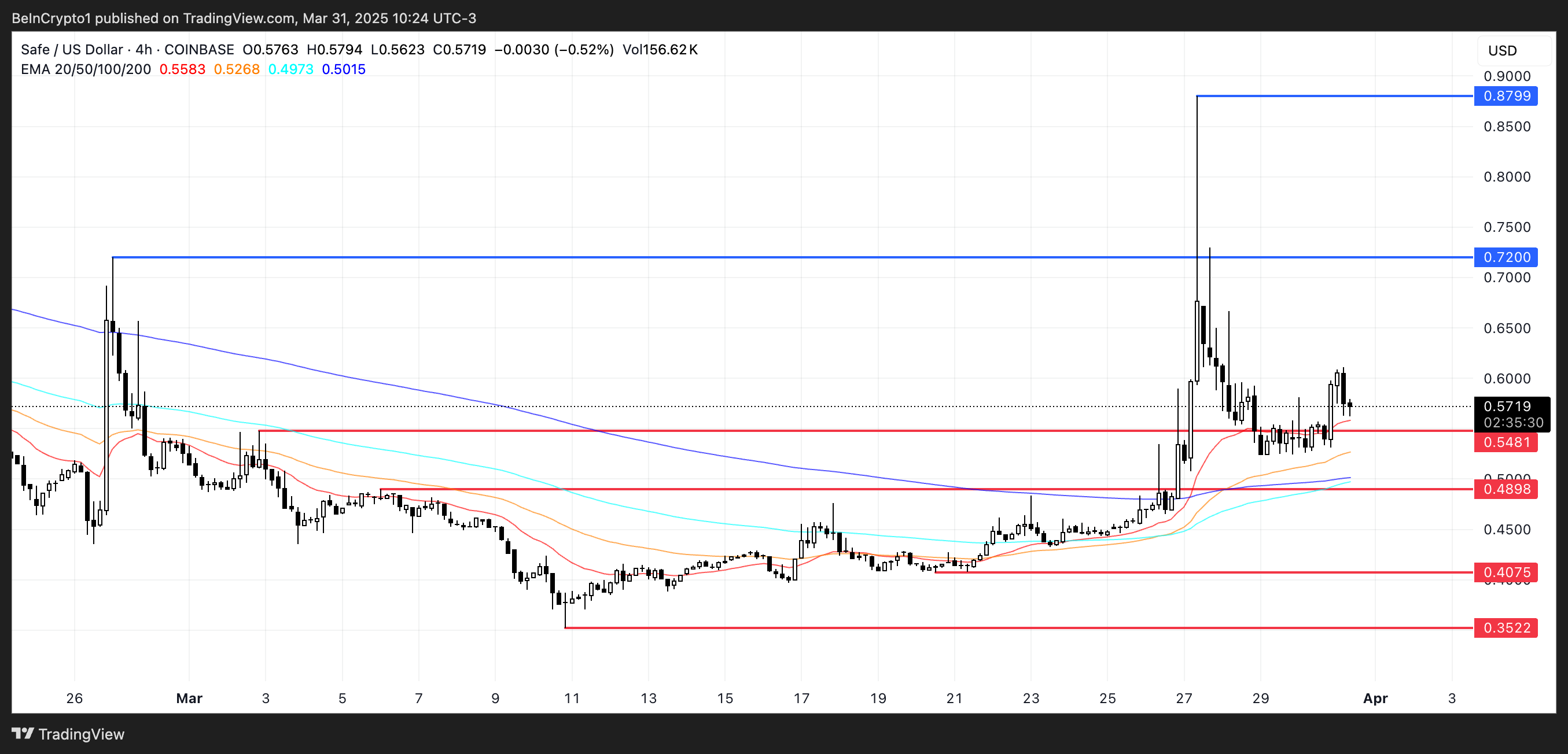
On the other hand, as indicated by the RSI and BBTrend indicators, the uptrend appears to be losing some momentum. This could signal a potential reversal in the near future.
If the trend does reverse, SAFE might test the nearby support level at $0.54, which sits precariously close to the current price.
Should this support level fail to hold, further downside could see SAFE decline to test subsequent support levels at $0.48 and $0.40. In a worst-case scenario, a drop all the way to $0.35 could potentially occur.
Disclaimer
In line with the Trust Project guidelines, this price analysis article is for informational purposes only and should not be considered financial or investment advice. BeInCrypto is committed to accurate, unbiased reporting, but market conditions are subject to change without notice. Always conduct your own research and consult with a professional before making any financial decisions. Please note that our Terms and Conditions, Privacy Policy, and Disclaimers have been updated.
Market
Trump Family Gets Most WLFI Revenue, Causing Corruption Fears
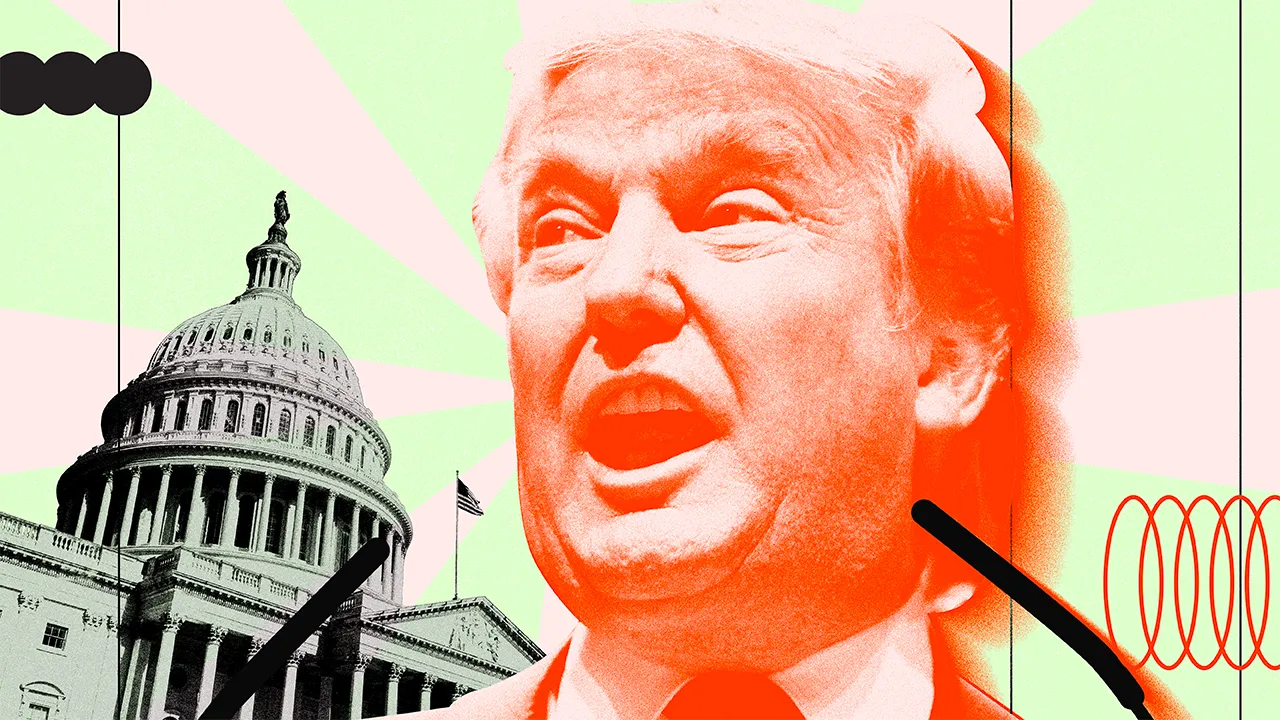
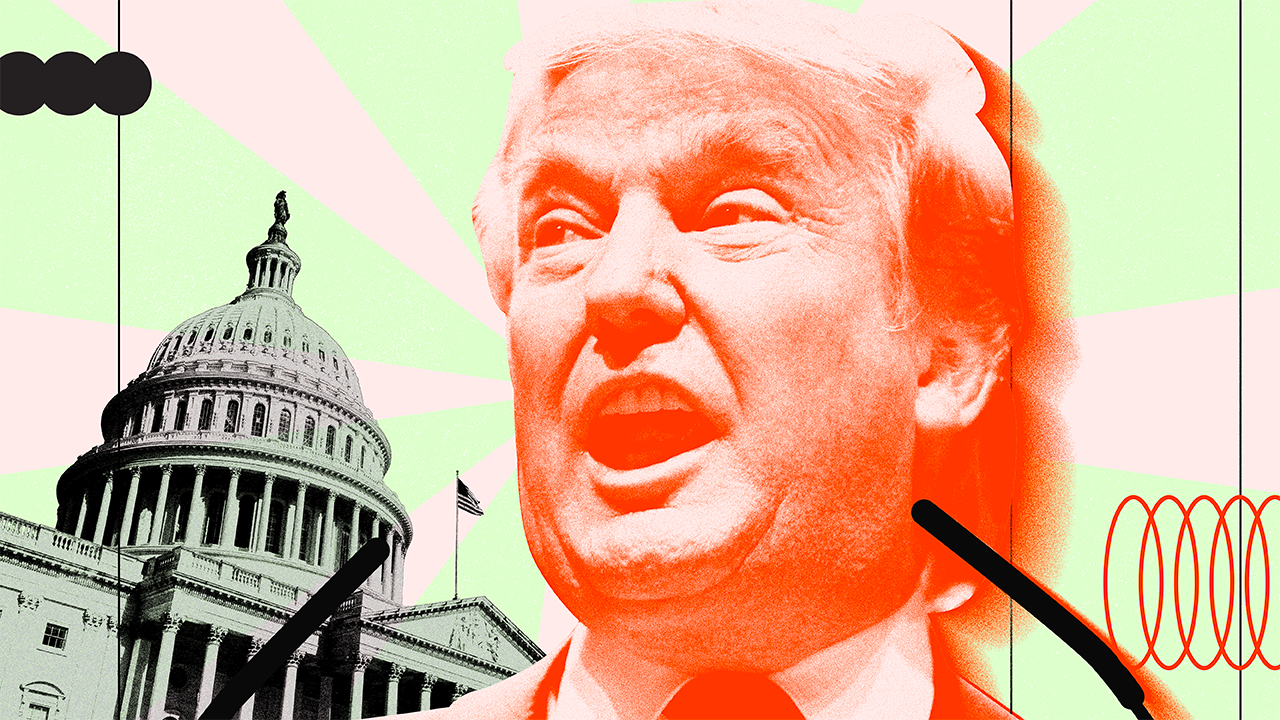
A new report claims that President Trump and his immediate family receive most of WLFI’s revenues. The Trumps are entitled to 75% of token sale revenues, about $400 million, and 60% of other incomes.
If these numbers are even partially accurate, they raise significant concerns about potential conflicts of interest. They also raise questions about the broader implications for transparency and accountability regarding Trump’s crypto policies.
Does the Trump Family Receive WLFI Proceeds?
World Liberty Financial (WLFI), a project affiliated with President Trump, has made a lot of waves in the crypto space since the end of last year. After persistent rumors of a Binance partnership, WLFI officially launched a new stablecoin, USD1. There is no clear evidence of Binance’s involvement in this launch. However, a new report from Reuters has disclosed some disturbing details.
Essentially, it claims that it has found evidence of how much of WLFI’s revenues go directly to Trump’s family. Trump will get 75% of revenues from token sales and 60% from subsequent operations. WLFI completed its major token sale, which would, therefore, entitle the Trumps to about $400 million.
Reuters calculates that 5% of proceeds from this token sale would actually fund WLFI’s platform, with the rest going to other co-founders. Further, its buyers are not able to actually resell their tokens, and it’s unclear what governance actions they could influence. There’s not an apparent reason for the average retail trader to actually buy these assets.
If these numbers are true, they could represent a serious conflict of interest and a dire threat to the US economy. First, community leaders like Vitalik Buterin warned of corruption from political meme coins like TRUMP. If Trump gets a cut of WLFI’s token sales, that’s already a huge avenue for misuse.
Additionally, since Trump is making huge changes to US financial regulators, there may not be anyone to investigate WLFI corruption allegations. For example, TRON founder Justin Sun invested $30 million into WLFI, and the SEC settled a fraud case against him months later. The SEC has been settling all its crypto enforcement actions, but this investment still looks relevant.
“You’ve got the guy in charge who is responsible for his own regulation. WLFI tokens would be the perfect vehicle for governments or oligarchs overseas to funnel money to the president,” former regulator Ross Delston claimed.
The biggest danger might not even come from political corruption or fears of centralization in crypto. Trump recently outlined a plan to use stablecoins to promote dollar dominance, and WLFI now has its own stablecoin. It also has around $111 million in unrealized losses due to its crypto investments and claims it will use “other cash equivalents” in USD1’s reserves.
It’s hard to overstate the potential risks involved. Given Trump’s financial stake in WLFI, there’s a clear incentive to promote the firm’s stablecoin as part of his “dollar dominance” agenda. If this leads to widespread investment in USD1 and the peg doesn’t hold, the consequences could ripple across the entire crypto market.
Simply put, this sort of business arrangement is totally unprecedented for a sitting US President. A few Senators are already investigating Trump’s connections with WLFI. However, their lack of political power and defanged federal regulators may hamper their ability to change anything.
Disclaimer
In adherence to the Trust Project guidelines, BeInCrypto is committed to unbiased, transparent reporting. This news article aims to provide accurate, timely information. However, readers are advised to verify facts independently and consult with a professional before making any decisions based on this content. Please note that our Terms and Conditions, Privacy Policy, and Disclaimers have been updated.











